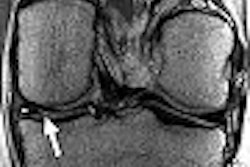BERLIN - In theory, functional MRI offers the ultimate noninvasive, presurgical management tool for brain tumor resection. In practice, fMRI techniques have a way to go before they can be as accurate as intraoperative cortical stimulation (ICS), according to Dr. Stefan Sunaert, Ph.D., from the University Hospital of the Catholic University of Leuven in Belgium. Sunaert discussed some of the strengths and weaknesses of fMRI for brain tumor mapping in a talk Sunday at the International Society for Magnetic Resonance in Medicine (ISMRM) meeting.
"What we want to use fMRI for is to avoid surgical damage to eloquent cortical areas," he said. "The gold standard is ICS. We might be able to replace this invasive method with noninvasive fMRI. This would avoid cases where the surgeon opens up the brain, does ICS, sees the tumor is inoperable, and just closes the patient up again. This is very frustrating for the neurosurgeon and the patient."
Other advantages of blood oxygenation level-dependent (BOLD) fMRI are the ability to determine if surgery is feasible or if conservative therapy would be appropriate. It can also be used to assess patient risk and single out patients who may still benefit from ICS. It also offers landmarks to guide surgeons during the procedure or during stereotactic biopsy.
"fMRI becomes useful when you are lost in your neuroanatomy," Sunaert said. Often, a lesion can shift normal anatomy. BOLD fMRI results can help surgeons avoid these areas that are displaced but still functioning normally. The same holds true for areas of function that are relocated to other parts of the brain by the tumor, called plasticity, he added.
Some of the pitfalls for presurgical BOLD fMRI are very technical: the search for the optimal scanning technique and disturbance of the fMRI signal, as well as signal dropout. There is also the accuracy of the localization of the BOLD signal.
"Remember that with BOLD fMRI, we are not looking directly at electrical neuroactivity, but indirectly at vascular effects. We are not looking at brain activity per se. We're looking at changes in brain activity between two or more brain states," Sunaert said.
The BOLD signal can be influenced by everything from common pharmacological agents (drugs for diabetes or asthma) to a cup of coffee (caffeine is a known booster of BOLD response), he noted.
Then there is the matter of which areas of the brain are expendable versus those that are essential. Can fMRI be the deciding factor? Not yet, Sunaert said. "Some areas of the brain are less prone to inducing a long-lasting deficit. Therefore, it is essential for us to develop paradigms that can tell us which areas will be expendable, and recognize and isolate these areas," Sunaert said.
Finally, can fMRI quash the conventional wisdom that if there is a distance of more than 2 cm between an eloquent area and a tumor, there is almost no chance of inducing a deficit? Sunaert declared that this "golden rule" in neurosurgery was wrong, but stopped short of promising that fMRI results could prove his theory.
But all is not lost for presurgical fMRI, he added. Beefing up BOLD fMRI with diffusion tensor imaging (DTI) can give surgeons a more realistic picture of the area under consideration for resection. Tumor borders on fMRI and DTI would be likely to differ from histological borders, preventing situations in which the surgery actually causes damage to healthy wiring tracts, resulting in a brand-new neurological deficit, he said. However, one of the major pitfalls of DTI is that it cannot track fiber crossing, kissing, or branching, which may mean that parts of spinal tracts are missed altogether, he added.
"The combination of fMRI and DTI is very useful," Sunaert concluded. "I think I can say that fMRI might be useful in order to have some presurgical risk estimation and to guide the neurosurgeons. The technique is now being validated in terms of patient outcomes."
Previous studies have indicated an 80% to 85% success rate for presurgical MRI, Sunaert wrote in a paper last year. Combining fMRI with DTI will bring the modality closer to clinical acceptance, he said. In the meantime, neuroradiologists need to continue to improve their presurgical fMRI technique and develop standards for statistical postprocessing (Journal of Magnetic Resonance Imaging, June 2006, Vol. 23:6, pp. 887-905).
By Shalmali Pal
AuntMinnie.com staff writer
May 21, 2007
Related Reading
Functional MRI allows more aggressive brain tumor treatment, August 31, 2006
PET trumps MRI for brain cancer chemo response, July 7, 2006
Copyright © 2007 AuntMinnie.com



.fFmgij6Hin.png?auto=compress%2Cformat&fit=crop&h=100&q=70&w=100)




.fFmgij6Hin.png?auto=compress%2Cformat&fit=crop&h=167&q=70&w=250)











